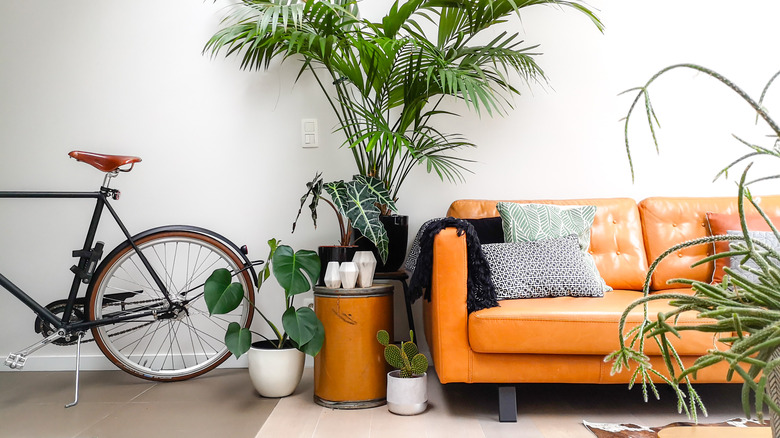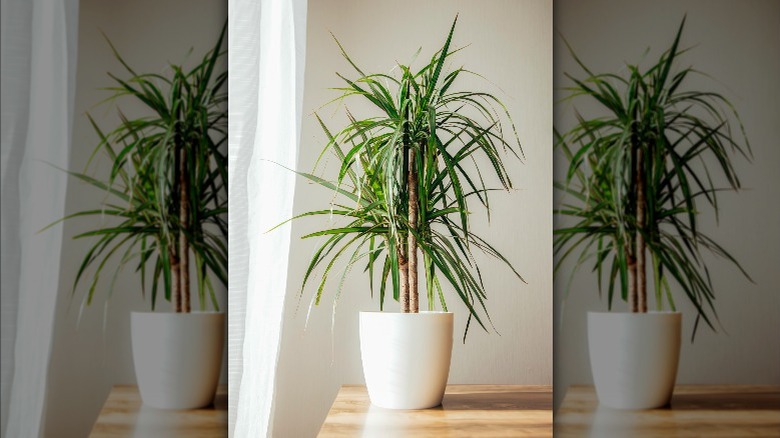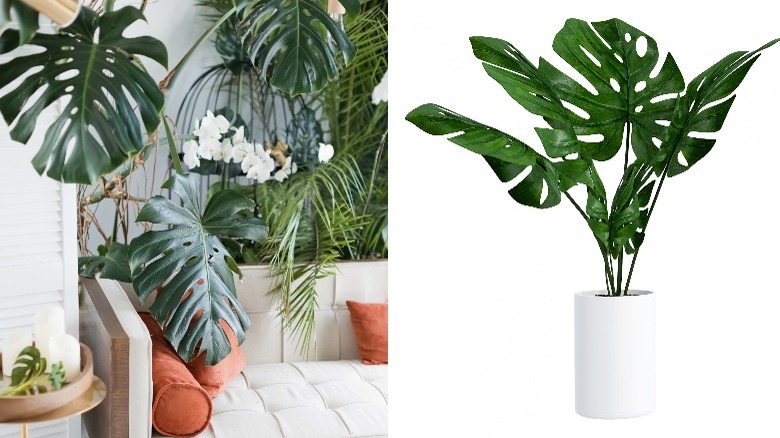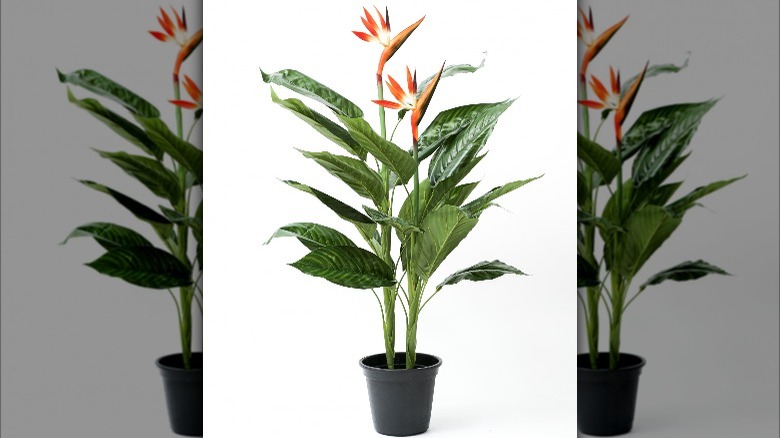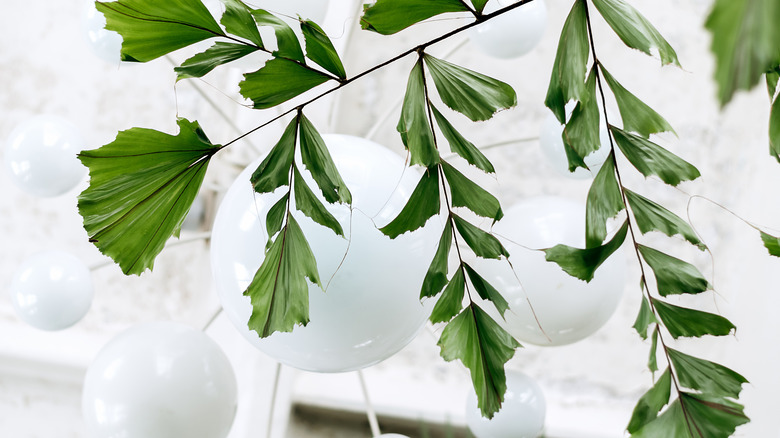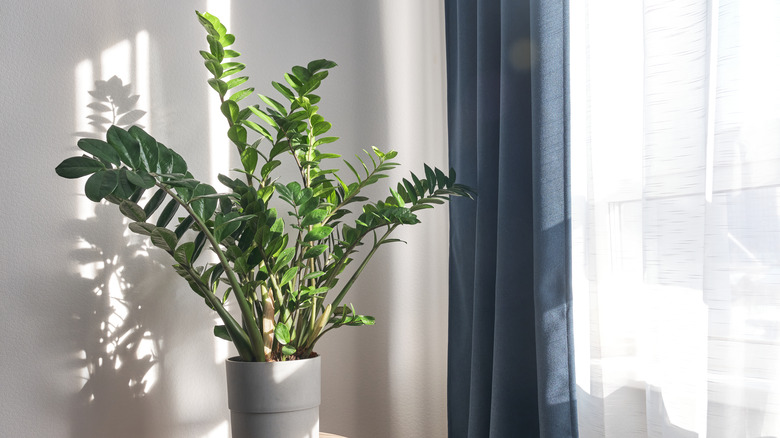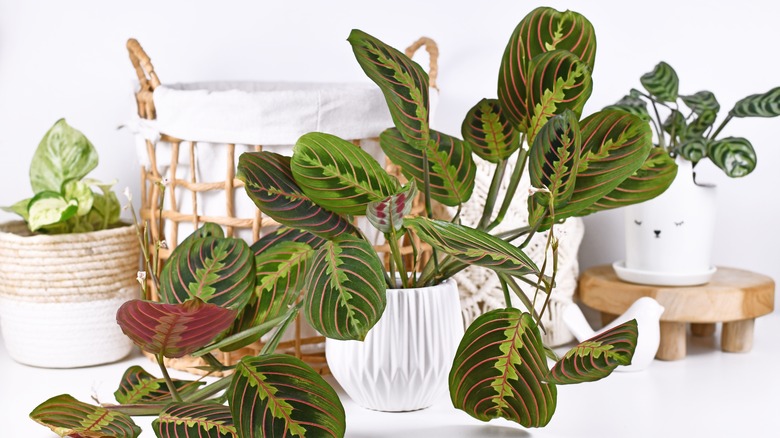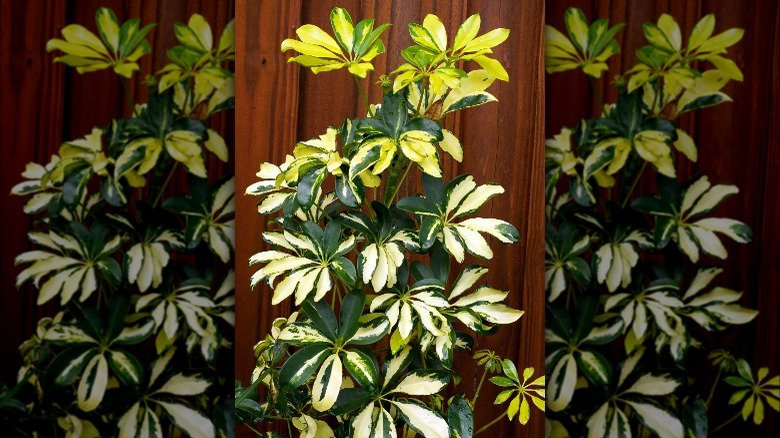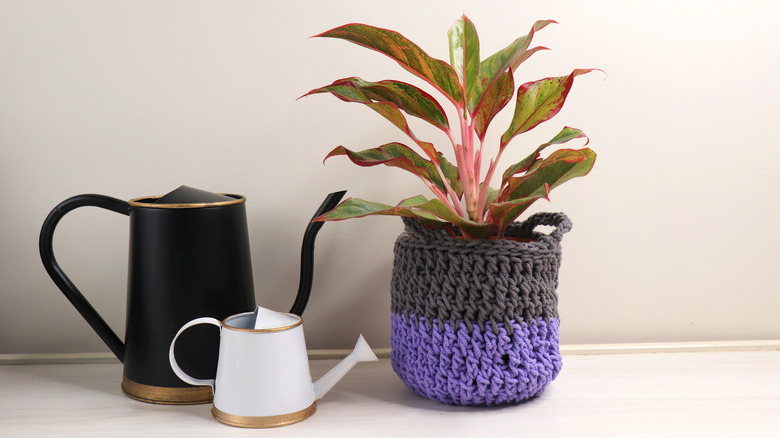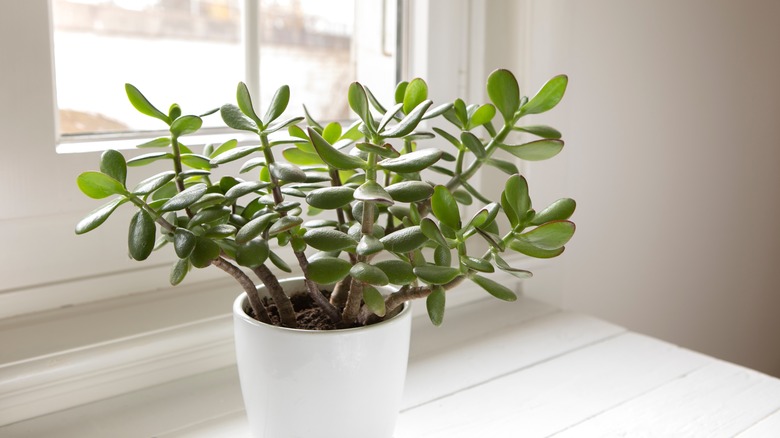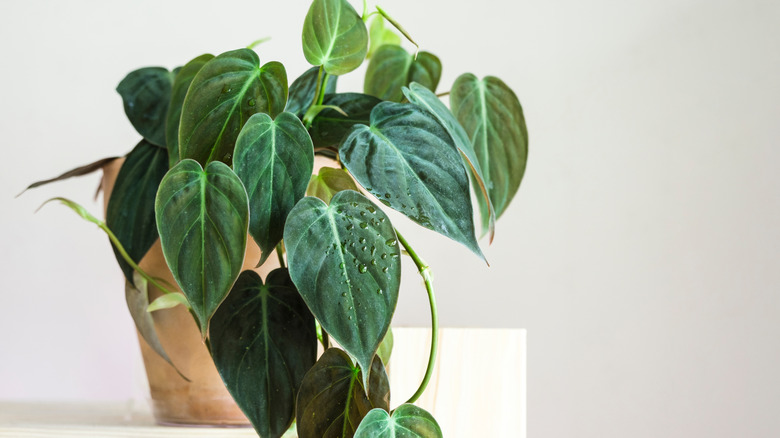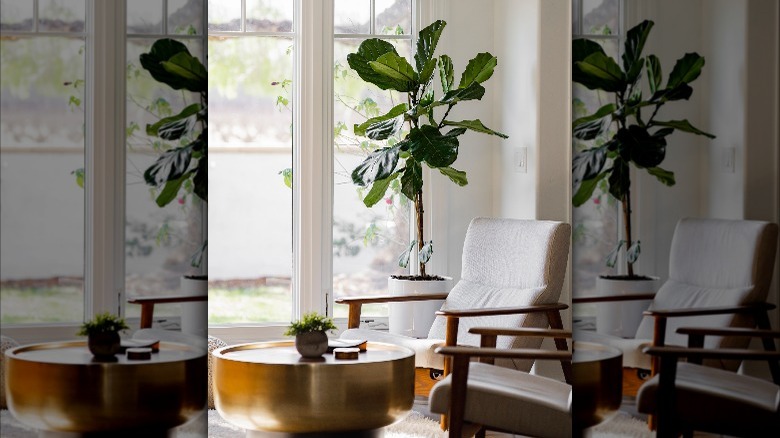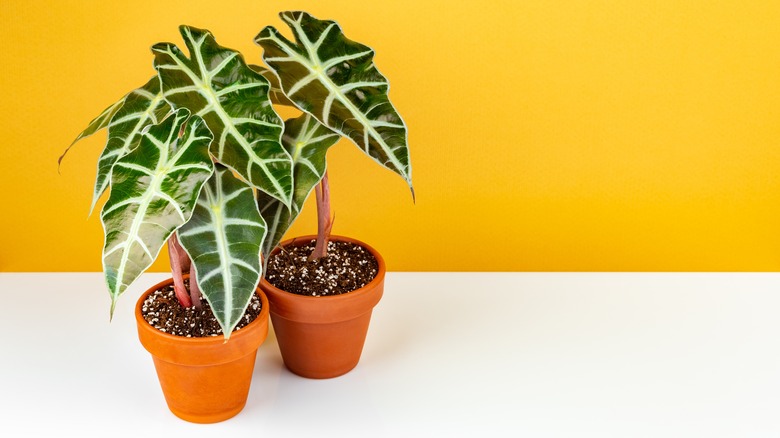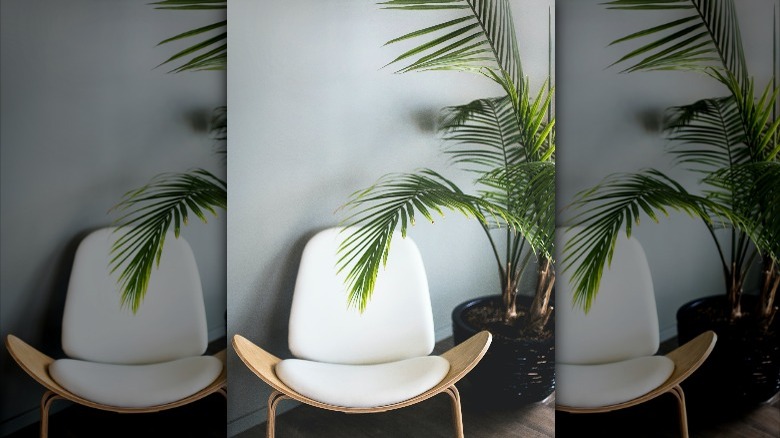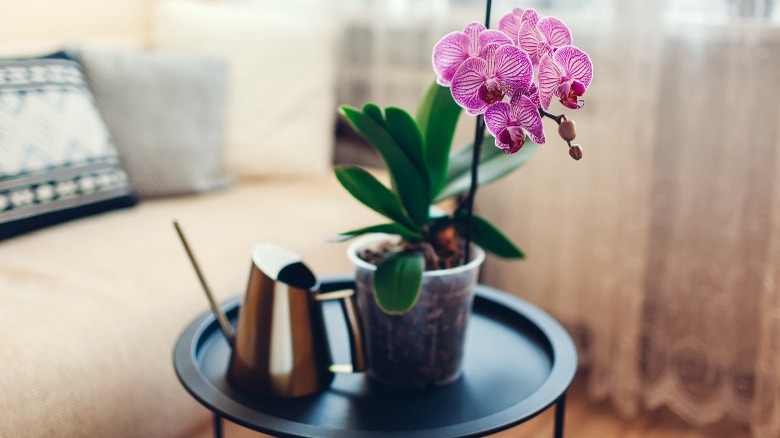15 Houseplants Perfect For A Mid-Century Modern Home
Mid-century modern (MCM) style is well-recognized for clean unfettered lines, sculptural forms, and a compelling mix of natural and futuristic inspirations. The founders of Home Union, a MCM-focused housewares showroom, offered a suggestion when designing with mid-century modern décor. "It's best to not have everything be too low or too high. Mix it up," Meghan Lavery and Daniel King encouraged. "We love a low sofa and a low coffee table, but try adding in an arc lamp as a contrast in height and to complete the space," they explained in Architectural Digest. As the last layer, "We love plants, floor pillows, and rocks, but we do our best to remain clutter free," the duo noted. Houseplants are a natural element simpatico to the era's numerous sensibilities and influences; they are by turns spiky, biomorphic, mounding, and arching. Plants can also be glamorous, organic, neutral, and colorful. In other words, the perfect MCM accessory.
Beards and Daisies claims it's precisely the unfussy and spare aesthetic of mid-century modern that makes it such an ideal backdrop for lush greenery. In addition, the large windows and expanses of glass typical of the architecture create an environment where indoor plants can thrive. Exotic varieties, succulents, and cacti are popular choices, and generally, the form and growth habit of foliage take precedence over flowers. With that in mind, here are 15 houseplants to enhance the inside of your mid-century modern home.
1. Madagascar dragon tree
The Madagascar dragon tree (Dracaena cincta) provides height and energy in a mid-century modern space with low silhouettes. According to NC State Extension, the broadleaf evergreen can reach heights of between 6 and 15 feet as a houseplant, unless pruned shorter. The linear, spiky leaves develop in a spiral formation, falling from the bottom to create a bare trunk scored with a textural pattern. The plant can display yellow-orange berries, but rarely flowers when cultivated indoors. Per Pet Poison Helpline, it's toxic to pets if ingested.
Sunlight Needs: Bright, indirect light
Water Needs: Moist well-drained soil
2. Swiss cheese plant
The Swiss cheese plant (Monstera deliciosa) is recognizable for its oversized and distinctive perforated foliage. The climbing tropical vine is native to Mexico and Central America, where it can grow up to 70 feet tall, per Missouri Botanical Garden; indoors, expect growth near 8 feet. The lower aerial roots can be planted into the soil to provide nourishment to the parent plant; a peat-heavy potting mix is suggested. Monstera is toxic for pets if ingested, per the ASPCA.
Sunlight Needs: Bright, indirect light
Water Needs: Moist well-drained soil, moderate humidity
3. Bird of paradise
Bird of paradise (Strelitzia reginae) is a stunning plant with large glossy leaves and an orange and blue flower reminiscent of a vivid tropical bird. Lauded for its striking appearance, the plant is native to South Africa but has been widely exported. Outdoors, real birds are attracted to them, and in return for a drink of the flower's nectar, their feet become dusted with pollen (via University of Wisconsin-Madison). According to the ASPCA, they are mildly toxic to dogs, cats, and horses.
Sunlight Needs: Full sun for prolific blooming
Water Needs: Water once dry
4. Fishtail palm
The fishtail palm (Caryota mitis) is named for its delicate and ribbed leaves. Native to Southeast Asia, where it can grow up to 40 feet, it adds a whimsical presence to a plant collection indoors, where it can reach nearly 10 feet in height. In maturity, the plant displays flowers and berries, which are poisonous if ingested or handled, notes NC State Extension. Insufficient light and dry air are the primary challenges to indoor care of the fishtail palm.
Sunlight Needs: Bright, indirect light
Water Needs: Moist well-drained soil, prefers humid conditions
5. Zanzibar gem
Zanzibar gem (Zamioculcas zamiifolia), also called the ZZ plant, is a smaller specimen than our previous picks. It will grow only 2 to 4 feet in height and width, and the dense, waxy foliage and low maintenance make it worth its indoor plant real estate. The semi-evergreen can be cared for in a similar manner to a succulent, notes Missouri Botanical Garden, as it is exceptionally drought tolerant. The ZZ plant is moderately toxic to cats and dogs.
Sunlight Needs: Bright, indirect light
Water Needs: Well-drained soil, water once dry
6. Prayer plant
The prayer plant (Maranta leuconeura), also known as cathedral windows, is an evergreen tropical plant. The showy leaves are patterned with red stripes emanating from a bright green center; the undersides have a gray-green coloration. At night they fold and appear like hands in prayer. Its size and habit make it ideal for a hanging basket, per NC State Extension. There are no serious challenges regarding pests or diseases, and it is non-toxic.
Sunlight Needs: Indirect light
Water Needs: Moist soil during the growing season, allow to dry between waterings in winter, prefers humid conditions
7. Umbrella plant
The umbrella plant (Schefflera Arboricola), also called the dwarf Hawaiian schefflera, is a fast-growing broadleaf evergreen shrub. Glossy solid green or variegated foliage grows in circular groupings that echo its namesake; pinch back new growth or prune the plant occasionally to maintain its shape. It produces berries and deep red flowers, yet will rarely bloom when grown indoors. Per NC State Extension, the leaves are moderately toxic to humans and pets if swallowed.
Sunlight Needs: Bright, indirect light
Water Needs: Water once dry
8. Red Chinese evergreen
Red Chinese evergreen (Aglaonema 'Red Gold') is an herbaceous perennial known for its pretty and colorful leaves. Per Missouri Botanical Garden, the low-maintenance houseplant is native to tropical Asia, and reaches a height and spread of 1 to 3 feet. Leaves are at their most vibrant with regular indirect light and direct sun in the early part of the day; insufficient light produces dull coloration while intense light can scorch them. Chinese evergreens are toxic to pets if chewed or ingested (via Pet Poison Helpline).
Sunlight Needs: Indirect light
Water Needs: Moist well-drained soil, prefers humid conditions
9. Jade
Jade (Crassula ovata), also called the friendship or money plant, is an ornamental with wide appeal. According to University of Wisconsin-Madison, the succulent is easy to care for and thrives in containers by storing water in its roots, stem, and foliage. For optimal growth, it should be repotted every couple of years. The stems can be pruned to promote fullness or the plant can be trained into a bonsai. Per the ASPCA, jade leaves are toxic for pets if ingested.
Sunlight Needs: At least four hours of direct sun per day
Water Needs: Well-drained soil, water once dry
10. Heartleaf philodendron
The heartleaf philodendron (Philodendron hederaceum) is an evergreen plant indigenous to Mexico, Brazil, and the West Indies. The low-maintenance houseplant displays shiny heart-shaped leaves that present in various colors including green, red, copper, and purple, according to NC State Extension. Trailing stems can be trained or left suspended; pinch them back to encourage denser growth. Indoors, heartleaf philodendrons will reach an average of 4 feet in height. They are slightly toxic to humans and pets if ingested.
Sunlight Needs: Bright, indirect light
Water Needs: Moist well-drained soil, allow to dry between waterings in winter
11. Fiddle leaf fig
The fiddle leaf fig (Ficus lyrata), also called the banjo fig, is a broadleaf evergreen named for the shape of its large leaves. It has enjoyed immense popularity in recent years, becoming a favorite interior plant. Native to Africa, the tree can reach 100 feet, however, as a houseplant, its maximum height is approximately 10 feet (via Missouri Botanical Garden). Although it's a stunning addition for houseplant aficionados, be advised per Kitsap Humane Society, that the fiddle leaf fig is poisonous to cats and dogs if ingested.
Sunlight Needs: Indirect light
Water Needs: Well-drained soil, water once dry
12. Elephant ears
The appeal of the Alocasia polly cultivar (Alocasia x amazonica 'Polly'), also known as the African mask plant or elephant ears, is its intriguing foliage. Large scalloped leaves are marked with contrasting white or light green ribs and sit atop slender stems. Additionally, it has been selectively bred for a scale amenable to indoor growing, reaching a compact 2 feet at maturity (via Garden Betty). The Alocasia genus can be toxic if chewed or ingested, per National Capital Poison Center.
Sunlight Needs: Bright, indirect light
Water Needs: Moist well-drained soil, prefers humid conditions
13. Kentia palm
Kentia palm (Howea forsteriana), also called the paradise palm, is an ideal plant for indoors because of its ease of care and dramatic presence. Feathery fronds give the specimen a balmy tropical appearance; yet according to University of Florida, the plant cannot tolerate high heat and humidity. Originating on Lord Howe Island off the eastern Australian seaboard, these palms prefer coastal climates and can survive outside in USDA hardiness zones 9b to 11. Potted kentia palms will top out at 12 feet.
Sunlight Needs: Moderate, filtered light
Water Needs: Well-drained soil, water once the top 25% is dry
14. Moth orchid
The tropical moth orchid (Phalaenopsis spp.) suits a mid-century modern aesthetic perfectly. It's dramatic yet minimal, and the remarkable plant is widely available. The blooms are found in several colors including white, green, pink, and lavender, and can last for up to six months (via Missouri Botanical Garden). Phalaenopsis can be grown in sphagnum moss or bark, however, once the material breaks down the orchid should be repotted. Moth orchids prefer daytime temperatures ranging from 70 to 80 degrees and a draft-free location.
Sunlight Needs: Indirect light
Water Needs: Well-drained material, prefers high humidity
15. Snake plant
The snake plant (Dracaena trifasciata) is notorious for its durability among houseplants. It seems anyone can grow and enjoy this tall sculptural evergreen, also known as the good luck plant, with minimal fuss. According to NC State Extension, it was designated as a clean air plant after NASA discovered it has the ability, among other indoor plants, to reduce pollutants such as formaldehyde and ammonia to improve air quality. Snake plants pose low-severity toxicity if ingested.
Sunlight Needs: Indirect light
Water Needs: Well-drained soil, water once dry, water only every 4 to 8 weeks in winter
